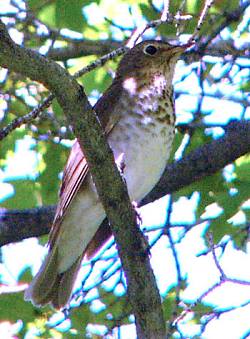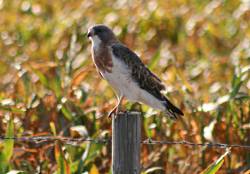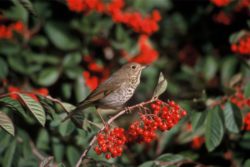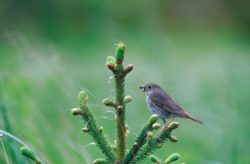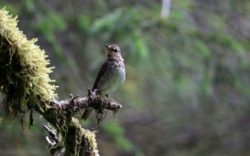
Courtesy US NPS
Robbie Hannawacker, Photographer (thrush)
Albert Myran, Photographer (meadowlark)
Combined by Patrick Kelly
I do remember my first, how can one not, that first call which bamboozled and hypnotized me years ago, both awakening and soothing that inside of me which makes me human. I used to live in a small cabin in the middle of Alaska, and during the eternal summers I’d hear this bird’s haunting call lull me to sleep. It was a Weddell seal of the woods. A UAP that sang.
At first, I didn’t want to know who it was filling the woods with quicksilver honeydew, drop by drop. I somehow felt that the magic would be lost, that by knowing the source I would ruin the spring. But then one day, the music maker appeareth. He was brown, squat, with a small thin beak, just sitting on a spruce branch at my eye level. When he sang, I found I was not disappointed. The Eden of unknowing bliss was not left behind. Instead, where once I saw an it, now I saw a thou. He was singing. The noble, sylvan Swainson’s Thrush.
This trend continued on for me, and once I moved to Utah, I found even more new strange songs. I learned to let the choir sing from their perches, and wait for them to show themselves. The newest singer I discovered was last summer, out in the last intact meadows which border the Bonneville Shoreline trail in Cache Valley, fast disappearing to the grind of half-acre plots and four-car garages which confuse godliness with gaudiness. In their loss, also deplete becomes their song.
Once I heard this new serenader, an avian Van Halen, I began repeating the trail just to hear his song. Like the thrush, which at this point was many years prior, his song seemed to have no source, it simply emanated from the golden grasses and muted sage which, pressed by wind, created a woven mat of gestalt terroir and echoed off the small crevices which led to the mountainsides.
So days and weeks went by as I hiked with my dogs. I’d keep an ear to the pastures and when I heard him, or his premonition upon the wind, I’d freeze and bend in. And sure enough, a certain day came where on this hike I listened, heard, and then saw him. Speckled brown back, golden chest with a black chevron, perched atop a scrubby little juniper calling into the wind. A Western Meadowlark at work.
So if this summer you hear a new sound in the full moon morning and don’t know who makes it, don’t shy, ignore, nor give up. The best thing you can do is to keep listening and keep waiting, be it your first or just most recent. Eventually the caller will pull the curtain back of their own accord and be revealed. So here’s my wish of good luck to you, that you will find what you’re listening for out in the world.
I’m Patrick Kelly, and I’m Wild About Utah.
Credits:
Images: Courtesy US National Park Service(NPS) Robbie Hannawacker, Photographer (thrush) & Albert Myran, Photographer (meadowlark)
Audio: Courtesy US NPS Media / David Betchkal (thrush) & US NPS & MSU Acoustic Atlas/Jennifer Jerrett (meadowlark)
Additional Audio Courtesy & © Kevin Colver, J. Chase and K.W. Baldwin.
Text: Patrick Kelly, Director of Education, Stokes Nature Center, https://www.logannature.org
Included Links: Patrick Kelly & Lyle Bingham, Webmaster, WildAboutUtah.org
Additional Reading
Wild About Utah, Posts by Patrick Kelly
Stokes Nature Center in Logan Canyon, https://www.logannature.org/
Bonneville Shoreline Trail, Logan Canyon Hiking, Bridgerland Audubon & Cache Hikers, site per Sarah Ohms, https://logancanyonhiking.com/bonneville.htm
Bonneville Shoreline Trail, Cache Hikers, https://www.cachehikers.org/Descriptions/BonnevilleShorelineTrail.html
Bonneville Shoreline Trail, Official Site(2016), https://www.bonnevilleshorelinetrail.org/
Swainson’s Thrush, All About Birds, Cornell Lab of Ornithology, Cornell University, https://www.allaboutbirds.org/guide/Swainsons_Thrush/overview
Swainson’s Thrush, American Bird Conservancy, https://abcbirds.org/bird/swainsons-thrush/
Swainson’s Thrush, UtahBirds.org, https://www.utahbirds.org/birdsofutah/ProfilesS-Z/SwainsonsThrush.htm
Western Meadowlark, All About Birds, Cornell Lab of Ornithology, Cornell University, https://www.allaboutbirds.org/guide/Western_Meadowlark
See Western Meadowlark in Sagebrush Communities in the Intermountain West, Bird Habitat Guide, American Bird Conservancy, https://abcbirds.org/wp-content/uploads/2015/05/SagebrushGuide.pdf
Western Meadowlark, UtahBirds.org, https://www.utahbirds.org/birdsofutah/ProfilesS-Z/WesternMeadowlark.htm

